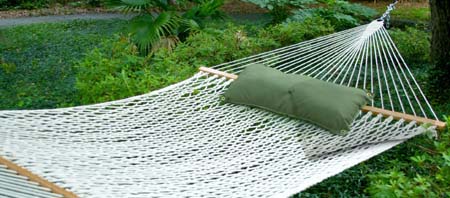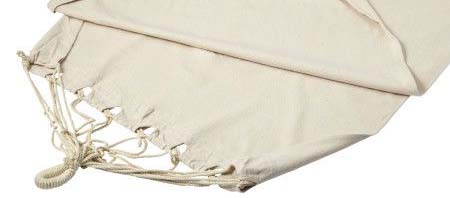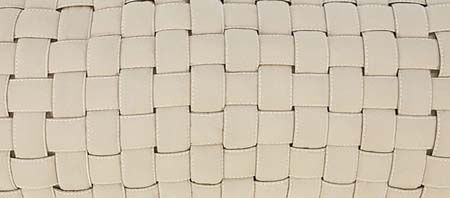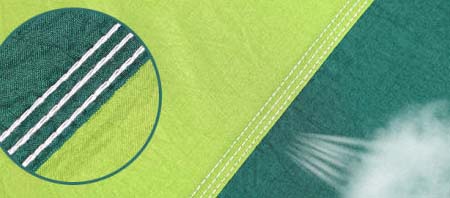As the sun sets over the campsite, I find myself gently swaying in my hammock, cocooned in a world of tranquility and nature’s symphony. Ah, the joy of camping and the embrace of a well-chosen hammock! But wait, there’s more to this story than meets the eye. Join me as we embark on a journey through the intriguing world of hammock fabric, where comfort and adventure intertwine.
Hammock Fabric Types
Following are the best hammock material available in the market.
- Cotton
- Polyester
- Duracord / Poly-Cotton
- Acrylic or Polypropylene
- Parachute Silk (Nylon)
- Canvas
Cotton

For those who cherish the feeling of a soft embrace in the midst of nature, cotton hammocks are a campsite staple. They provide comfort reminiscent of home, but campers must beware of mold and fading under outdoor conditions.
Polyester

Campers who brave the elements require a hammock that’s tough and weatherproof. Polyester hammocks fit the bill perfectly, offering durability against mold, mildew, and fading. They’re a reliable choice for outdoor relaxation.
Poly-Cotton / Duracord

Combining the sturdiness of polyester and the coziness of cotton, poly-cotton hammocks offer campers the best of both worlds. These hammocks resist stains, fading, and even boast quick drying properties.
Canvas

Canvas hammocks, often made from cotton or polyester, are the rugged companions campers need. These hammocks have a storied history, popularized by the Navy, and are ready for any adventure you embark upon.
Acrylic or Polypropylene

For campers who desire vibrant colors that withstand the great outdoors, acrylic or polypropylene hammocks are an excellent choice. These fabrics boast impressive color retention and durability against the elements.
Parachute Silk (Nylon)

Campers always on the move will appreciate parachute silk hammocks. Made from nylon, these hammocks are featherlight and perfect for backpacking trips, ensuring comfort without adding excess weight.
Generally speaking, the choice is between cotton for comfort or polyester for durability. Deciding how your hammock will be used will help to determine what fabric you buy.
Cotton Hammocks: Embrace of Softness
Cotton, oh cotton! Its touch on my skin reminds me of my childhood blanket—comforting and familiar. A cotton hammock feels like home, cradling me with its natural fibers. But here’s the catch: while it’s the epitome of coziness, it’s a bit sensitive. Mold and mildew can be its foes, especially in damp environments. And don’t forget about the sun’s powerful rays—they can fade those natural hues. Best used indoors or under the sun’s watchful eye, my cotton hammock is my comfort haven.
Polyester Hammocks: Resilience in Every Thread
Out in the wilderness, where nature can be unpredictable, polyester hammocks shine as trusty companions. Their resilience against mold, mildew, and fading is impressive, making them the ultimate outdoor warriors. They stand strong against the elements, allowing me to focus on soaking in the serenity of the great outdoors. Though the color palette might lean towards the bright side, I must say, those vibrant hues bring a dash of cheer to my camping setup. Plus, durability is the name of the game here—I’m in for the long haul.
Poly-Cotton / Duracord: The Hybrid Marvel
Enter poly-cotton, a blend that offers the best of both worlds. The softness of cotton meets the robustness of polyester, resulting in a fabric that’s not only cozy but also hardy. Stains, fading, and mildew stand no chance against this mighty contender. And did I mention it dries swiftly? No more soggy hammocks after a rain shower. Whether I’m lounging indoors or letting the wind rustle through the trees as I camp outdoors, my poly-cotton hammock’s got my back.
Canvas Hammocks: Rugged Allure of the Outdoors
Ah, canvas—strong, sturdy, and a nod to the days of old. Historically used by sailors in the Navy, canvas hammocks evoke a sense of nostalgia. They’re built tough, woven to endure whatever the wilderness throws at them. But here’s the thing: there’s a variety of canvas out there, some made from cotton, some from polyester. The key is knowing which one you’ve got. Cotton canvas offers comfort, while polyester canvas is the unsung hero of outdoor durability. When I’m ready to tackle the untamed wilderness, my canvas hammock becomes my reliable partner in adventure.
Acrylic or Polypropylene Hammocks: Pops of Color Amidst Nature
Bright and bold—acrylic or polypropylene hammocks don’t shy away from making a statement. Their vivid colors refuse to fade even in the face of intense sunlight. I feel like an artist painting my campsite canvas with these vibrant hammocks. They’re a perfect match for places where nature’s palette meets my own. The durability factor? No worries there. These hammocks are as tough as they are colorful, promising a comfortable and eye-catching experience.
Parachute Silk (Nylon) Hammocks: Featherlight Exploration
For my fellow adventurers, let’s talk parachute silk hammocks. Made from nylon, they’re featherlight, making them a backpacker’s dream. When I’m on the move, weight matters, and these hammocks tick that box with finesse. They might not have the plushness of cotton, but they make up for it with their portability. Whether I’m scaling mountains or exploring dense forests, my parachute silk hammock is a reliable companion, providing comfort without the extra load.
Conclusion: A Tale Woven in Fabric
As I pack up my camping gear, I can’t help but marvel at the role hammock fabric plays in shaping my outdoor escapades. Each type tells a unique story, catering to my preferences and needs. From the gentle cradle of cotton to the resilient embrace of polyester, every fabric has a place in my camper’s heart. And as I bid farewell to the campsite, I’m already dreaming of the next adventure that awaits, where my chosen hammock fabric will be the canvas for my memories.
For outside use, you also need to make sure that the stand and attachments are fully weatherproof. You can read more about stands on other pages of this site.
Camper’s FAQs: Unveiling Hammock Fabric Mysteries
- Q: Can I use a cotton hammock in the great outdoors?
A: Absolutely! While cotton is cozy, keep it sheltered from moisture and direct sunlight to prevent mold and fading. - Q: How do polyester hammocks fare in outdoor conditions?
A: Polyester hammocks are outdoor champions, with impressive mold, mildew, and fade resistance. They’re built to thrive in nature’s embrace. - Q: What’s the ideal fabric for rugged camping?
A: Canvas hammocks, whether made from cotton or polyester, are built to withstand the wild. They’re your go-to for durability in adventurous terrains. - Q: Are parachute silk hammocks comfortable for backpacking?
A: Parachute silk hammocks offer lightweight comfort, making them perfect for backpackers who value portability without compromising on relaxation. - Q: Which fabric blends comfort and durability?
A: Poly-cotton hammocks strike the perfect balance, offering campers the softness of cotton and the resilience of polyester—a harmonious blend for all adventures.

